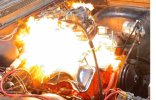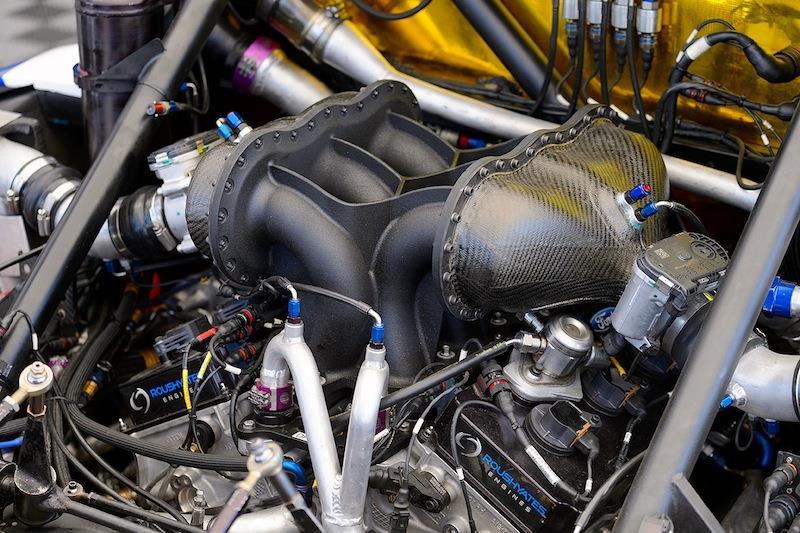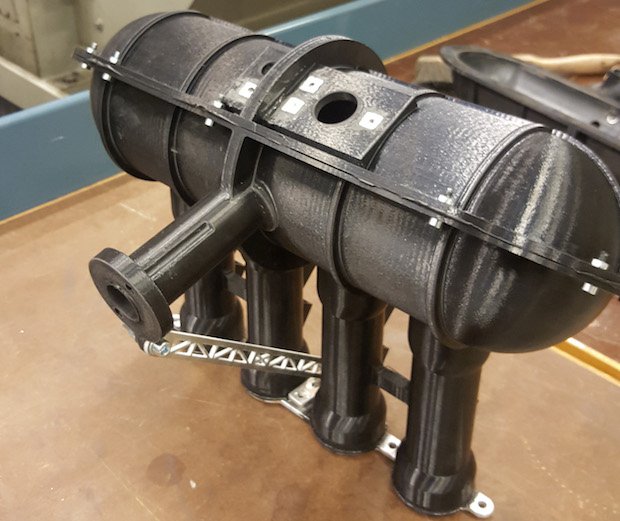Actually, that was one of my first questions when deciding on which polymer we were going to use to make these. Scuff it and spray away! Clearly the paints that specifically say they bond to plastic will be best. Also keep in mind the entire intake is going to stay cool unlike aluminum intakes that soak up the engine heat so I would think most paints will not only stick but shouldn't have any issues with heat as well.Randy, i realize this is still in the pre production stages but is this material paintable and or will there be an option for a silver, orange or red option!! Keep up the good work and get some rest when you can!
You are using an out of date browser. It may not display this or other websites correctly.
You should upgrade or use an alternative browser.
You should upgrade or use an alternative browser.
3D printed Intakes and other items coming for every 348-409 application.
- Thread starter 1964SuperStocker
- Start date
We are trying to figure the O-ring style out because the runners are so close together on the ports that a double O-ring may not be wise. Probably just make one silicone gasket and yes a channel on the intake is planned to hold it on the intake in place. Simple O-ring on the water ports will be standard.Forget the gaskets. Incorporate o-ring grooves into the design. Not sure how printable it would be but a captive groove like I cnc machine into parts is cats ass. O-ring cannot fall out.
Jeff
3D printed ceramic plug will be used. Little bit of high temp red RVT and never have to worry about it. We may have an external plug that gets two bolts near it to strap it down closed but we will see. Right now the ceramic 3D printed plugs are cheap and easy to stuff in the hole.Will the manifold be able to take the heat where it blocks off the crossover exhaust port?
Not going to be left open. LOL!Werould it hold the exhaust cross over heat with the cross over left open?
Making 3D printed throttle bodies isn't hard. Everyone and their brother is already doing it. Keep in mind we may machine or mold our own too. With 3D printing, the vast majority of what you can dream up can be made instantly. Some parts of every build require special pieces be created to help complete the build.I would be curious how a throttle plate will work in plastic to not wear and the stay in shape.
Check with Nick Smithburg @BOSSMAN on question for the Hilborn stack type injectors.

63409impala
Well Known Member
I may be interested in a crossram
Look at my profile picture. ME TOO! LOL! I've already had a chance to do some work with a M/T Power Ram. We will see if that is the direction we want to head or if a new design is needed. The Power Rams have a few issues that would be nice to engineer out of them.I may be interested in a crossram
63409impala
Well Known Member
I'll help R&D them if neededLook at my profile picture. ME TOO! LOL! I've already had a chance to do some work with a M/T Power Ram. We will see if that is the direction we want to head or if a new design is needed. The Power Rams have a few issues that would be nice to engineer out of them.
R&D is more risky then anyone might understand at the "how can we hurt this intake stage" we are at. Here is an image to help anyone who thinks this is simple, cheap, quick. I'll work on getting the video up of us blowing one up to give everyone an idea of what actual R&D looks like.I'll help R&D them if needed
 Its not for the faint of heart and besides, you have had enough engine issues in the past, you won't want to have to clean up from an "unscheduled rapid disassembly" and report on it to do it all over again in a couple days. To be fair, we scheduled the "rapid disassembly" and it performed exactly as I had hoped it would. Paving the way to a few simple mods to ensure our shade tree mechanics (who make more timing mistakes on average) will have a robust product to top their engine with. We are calling it the "Child proof stage". No sharpe edges, nothing to pinch fingers on and if you screw up your timing, then the pop-off plate will ensure the intakes will survive a blast like this just as the blower intakes already have on them. If I would have had my throttle blades open then the 1000cfm would have likely allowed for the fire to shoot straight up and out causing little or no damage. I wanted to squeeze a fire cracker in my hand and see what it would do and why. Performed as I hoped so it makes the next few steps quicker and easier to get past this stage of R&D. We will have a few more of these purposeful blow ups but they will be on engine stands because I have to pull the front off the wagon and start in getting it cleaned up, body work, some paint and drop the new 700r4 I've been let collect dust in the garage. Family is complete now so its time to go to car shows, trips and get burgers in the 9 passenger wagon. (I can edit any photo/video but I can assure anyone, that isn't CGI at work)
Its not for the faint of heart and besides, you have had enough engine issues in the past, you won't want to have to clean up from an "unscheduled rapid disassembly" and report on it to do it all over again in a couple days. To be fair, we scheduled the "rapid disassembly" and it performed exactly as I had hoped it would. Paving the way to a few simple mods to ensure our shade tree mechanics (who make more timing mistakes on average) will have a robust product to top their engine with. We are calling it the "Child proof stage". No sharpe edges, nothing to pinch fingers on and if you screw up your timing, then the pop-off plate will ensure the intakes will survive a blast like this just as the blower intakes already have on them. If I would have had my throttle blades open then the 1000cfm would have likely allowed for the fire to shoot straight up and out causing little or no damage. I wanted to squeeze a fire cracker in my hand and see what it would do and why. Performed as I hoped so it makes the next few steps quicker and easier to get past this stage of R&D. We will have a few more of these purposeful blow ups but they will be on engine stands because I have to pull the front off the wagon and start in getting it cleaned up, body work, some paint and drop the new 700r4 I've been let collect dust in the garage. Family is complete now so its time to go to car shows, trips and get burgers in the 9 passenger wagon. (I can edit any photo/video but I can assure anyone, that isn't CGI at work) 

That’ll make your heart skip a few beats!
on my phone. Haven't had a chance to get it loaded yet. Will work on that today.Where’s the video and sound clip????
I have a lot of questions!
1. You intentionally made the engine backfire while in the car knowing there may be the possibility that it could explode? Despite the fire risk?
2. Have you spoken to anyone that has printed complete intake manifolds that have had success with long term durability? As in years and
thousands of miles? I ask because I have not seen it done yet. Everything I have ever seen or heard about has been limited to prototypes and
short term use. Short term being under 100 hrs.
3. How resistant to today's pump gas are the materials? Will they absorb gas after long term use? Will the material become brittle?
4. What about vibration and cracking?
5. Is the printing process cost effective over a casting? Or even using the 3d printer to print dry sand cores? It would seem the 3d printing process
for a complete intake would be costly for a production run on something that would be a popular seller such as a small port 2x4 manifold.
6. I understand the materials are heat resistant beyond the operating range of an average engine, but what about heat AND pressure such as under
bolts? Will the material compress over time?
7. Have you done any flow work in general and dyno testing in the past?
8. Will you be using cfd simulations to help with your designs?
If I haven't kicked the hornets nest too hard yet, I would like to know more.
1. You intentionally made the engine backfire while in the car knowing there may be the possibility that it could explode? Despite the fire risk?
2. Have you spoken to anyone that has printed complete intake manifolds that have had success with long term durability? As in years and
thousands of miles? I ask because I have not seen it done yet. Everything I have ever seen or heard about has been limited to prototypes and
short term use. Short term being under 100 hrs.
3. How resistant to today's pump gas are the materials? Will they absorb gas after long term use? Will the material become brittle?
4. What about vibration and cracking?
5. Is the printing process cost effective over a casting? Or even using the 3d printer to print dry sand cores? It would seem the 3d printing process
for a complete intake would be costly for a production run on something that would be a popular seller such as a small port 2x4 manifold.
6. I understand the materials are heat resistant beyond the operating range of an average engine, but what about heat AND pressure such as under
bolts? Will the material compress over time?
7. Have you done any flow work in general and dyno testing in the past?
8. Will you be using cfd simulations to help with your designs?
If I haven't kicked the hornets nest too hard yet, I would like to know more.
I’m not jumping on the bandwagon of kicking the hornets nest, but I too had a question in my mind when I first read about this as to the plastic that you’re printing with…. Is it durable enough to support the weight of, gravity ,vibration, of dual carburetion an air cleaner assembly and linkage….will it remain flat and True……..I know they said that composite decking will not curl, will not warp, but I’ve seen those results ……….
Best for anyone that doesn't understand 3D printing to consider spending some time looking up other people who have done intakes already. Bolted them straight to the engine and run them in races where points, money and times are life. I've been following the tech for some time but never considered doing this myself because of the learning curve to print working parts is complex. Now that my buddy Scott is on board then all I'm really doing is guiding him through the process of constructing something to fit an old engine instead of one of his airplane parts.I have a lot of questions!
1. You intentionally made the engine backfire while in the car knowing there may be the possibility that it could explode? Despite the fire risk?
2. Have you spoken to anyone that has printed complete intake manifolds that have had success with long term durability? As in years and
thousands of miles? I ask because I have not seen it done yet. Everything I have ever seen or heard about has been limited to prototypes and
short term use. Short term being under 100 hrs.
3. How resistant to today's pump gas are the materials? Will they absorb gas after long term use? Will the material become brittle?
4. What about vibration and cracking?
5. Is the printing process cost effective over a casting? Or even using the 3d printer to print dry sand cores? It would seem the 3d printing process
for a complete intake would be costly for a production run on something that would be a popular seller such as a small port 2x4 manifold.
6. I understand the materials are heat resistant beyond the operating range of an average engine, but what about heat AND pressure such as under
bolts? Will the material compress over time?
7. Have you done any flow work in general and dyno testing in the past?
8. Will you be using cfd simulations to help with your designs?
If I haven't kicked the hornets nest too hard yet, I would like to know more.
Examples to wet one's whistle: (some of these are really old because this isn't a new technology or application)

Does 3D printing add up?
Additive manufacturing has long assisted prototyping, but OEMs are now exploring its uses in productionA hot topic for a number of years, it now appears that additive manufacturing (3D printing) technologies are starting to be used more widely by a number of automotive OEMs. But while additive...
CRP shows off functional intake manifold 3D printed in Windform materials at JEC World 2017
For the second year in a row CRP Technology has been invited to attend JEC World as exhibitor to showcase the latest innovations in the field of additive manufacturing with Windform high performance materials.

Swedish Formula Student team win race against time thanks to Stratasys 3D printing technology
A group of Swedish students, in the depths of developing a race car ahead of the annual Formula Student event at England’s famous Silverstone track, turned to the 3D printing technology offered by Stratasys to add the final touches to their vehicle.
 www.tctmagazine.com
www.tctmagazine.com
1. Had to blow it up somewhere and we needed it to happen sooner than later because I knew there was a risk for anyone to create a back fire. My engine is coming out and apart on the wagon this winter so logically, why not just blow it where it sets. We would have been set back 3-4 weeks in development if we would have waited to pull the engine. Clearly my wagon isn't some show queen and I had fire extinguisher on it in seconds. Unlike some things we can put off, there is a schedule we have set for ourselves to get a working product ready to go and to meet that schedule we have to make things happen now and not wait for a more sanitary environment to test to the extreme.I have a lot of questions!
1. You intentionally made the engine backfire while in the car knowing there may be the possibility that it could explode? Despite the fire risk?
2. Have you spoken to anyone that has printed complete intake manifolds that have had success with long term durability? As in years and
thousands of miles? I ask because I have not seen it done yet. Everything I have ever seen or heard about has been limited to prototypes and
short term use. Short term being under 100 hrs.
3. How resistant to today's pump gas are the materials? Will they absorb gas after long term use? Will the material become brittle?
4. What about vibration and cracking?
5. Is the printing process cost effective over a casting? Or even using the 3d printer to print dry sand cores? It would seem the 3d printing process
for a complete intake would be costly for a production run on something that would be a popular seller such as a small port 2x4 manifold.
6. I understand the materials are heat resistant beyond the operating range of an average engine, but what about heat AND pressure such as under
bolts? Will the material compress over time?
7. Have you done any flow work in general and dyno testing in the past?
8. Will you be using cfd simulations to help with your designs?
If I haven't kicked the hornets nest too hard yet, I would like to know more.
2. I have a large group of people that 3D print (and lucky enough) that live and work right here in DesMoines. I go to their meetings and bounce ideas off of the experts and tell you the truth, what I'm doing is pretty boring compared to what I've seen being created.
3. How many of us have Nylon parts in our carbs/fuel injection systems in the cars/trucks we drive ever day? I don't see any car manufacture worried about it so I'm not either. Really it comes down to picking the right materials to do the job. Again, where the experts come in.
4. Ever look out an airplane and see the wings flex? Carbon Fiber Nylon also has some give to it. If it cracks then you either didn't build it right or someone didn't use the object as it was designed.
5. 3D Printing is so much cheaper than casting. Changes to a print can be made during the print. What changes can you make to a casting halfway through the process? From design to working piece in days instead of months. No over head, no investment in over head with parts setting around. Plus you can customize it and print it in just a couple days. We plan on having more than just the 3 printers we currently run and don't expect everyone is going to want the same thing at the same time. Besides it only takes a day to construct another printer and get it printing so scaling up would be simple, quick and easy.
6. The kind of mounts you use are important because every bolt has a purpose. Again, the experts and some testing has given us some good results so far but I'm not convinced yet that we can rely on Carbon Fiber Nylon or special inserts to hold important items in place. We will see.
7. For this Series One intake, no flow work was done. Its simply a proof of concept that didn't need more than volume calculations for runners and plenum. This first simple design had one purpose in life to get us a running 434ci stroker W engine (with dual quads) and grab everyone's attention online. It did both successfully and now its time to change the design significantly.
8. I LOVE CFD (Computational Fluid Dynamics) is so ******* cool and fun. Design, simulate, design, simulate, design, simulate..... Taking the information about information to come up with a solution is my jam. The whole reason I was the marketing guy for ADM was because I love analytics. Filtering out the noise to create empirical evidence to support a finding is how I ended up becoming a law clerk. CFD is going to be one of the most interesting/fun aspects of this journey. Remember, no one has ever used CFD on factory 348-409 intakes. Once we have a better 3D scan system, I will be taking each and every factory casting and creating a flow graph for each one.
I hope some of this helps Dan.

